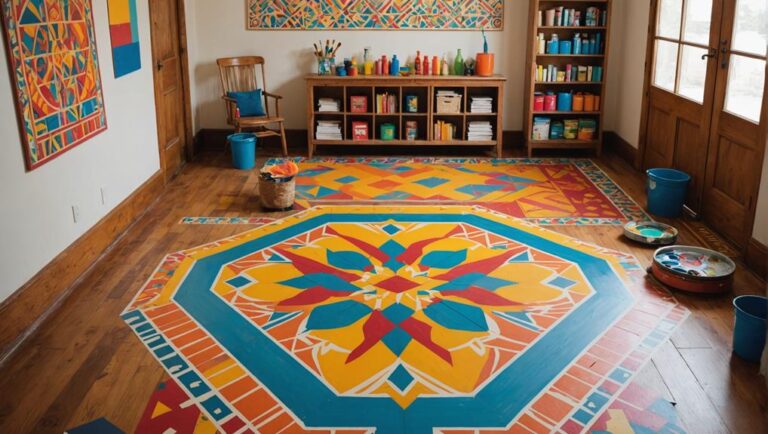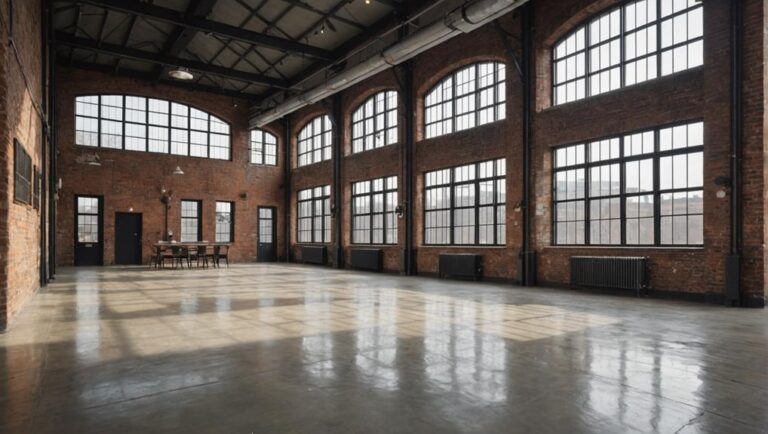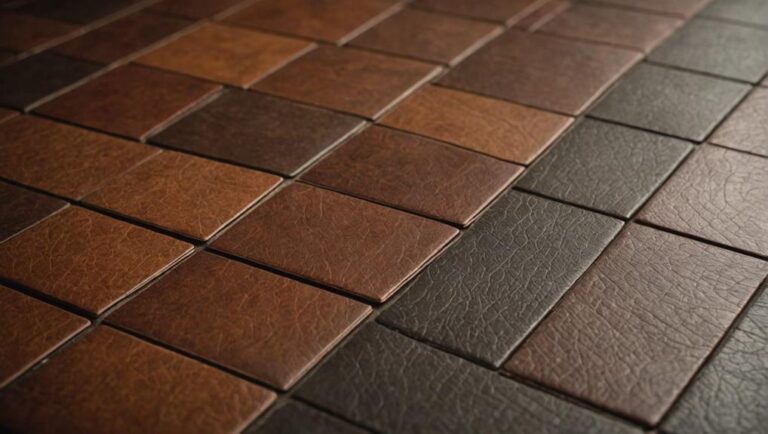To restore terrazzo floors, start by evaluating their condition for cracks, chips, or stains. Deep clean using a pH-neutral cleaner and rinse thoroughly. Repair any damage by filling cracks with epoxy and sanding down for a smooth finish. Next, grind the surface with diamond tools to remove imperfections, then polish using finer diamond pads for a high gloss. After polishing, make sure you seal the floors with an appropriate sealant to protect against future damage. Regular maintenance is essential for longevity. For thorough guidance on each step, you might find further insights particularly useful.
Assessing Floor Condition
Evaluating the condition of your terrazzo floors is essential before initiating any restoration process. Terrazzo flooring, which has a rich history dating back to ancient times, consists of a composite material made from chips of marble, glass, or other aggregates set in a cement or epoxy binder. Understanding the specific floor type in your space will help you identify any unique characteristics and challenges that might arise during restoration.
Begin your assessment by inspecting for visible damage, such as cracks, chips, or discoloration. It's vital to document these issues, as they will guide your restoration strategy. Pay attention to the presence of any stains or surface wear caused by heavy foot traffic, which can compromise the floor's integrity. Check for moisture issues as well, since water damage can lead to significant deterioration.
Next, evaluate the overall flatness of the surface. Uneven areas can indicate subfloor problems, which may require additional attention during the restoration process. Use a level to determine if the terrazzo is even across its entirety.
Additionally, consider the age of the floor and any previous restoration work that may have been performed. This knowledge can provide insight into the materials used and potential limitations on what can be done during restoration.
Cleaning the Surface
Once you've assessed the condition of your terrazzo floors, the next step involves cleaning the surface to prepare it for restoration. A clean surface is vital, as it allows for better adhesion of any repairing or sealing products you'll apply later. To guarantee your cleaning process is effective and safe, consider using eco-friendly products that won't damage your terrazzo's surface texture.
Here are three essential steps to follow for cleaning your terrazzo floors:
- Dust and Sweep: Begin by removing loose dirt and debris. Use a soft broom or a vacuum with a brush attachment to avoid scratching the surface. This initial step helps prevent any particles from scratching the terrazzo during the wet cleaning process.
- Mop with Eco-Friendly Cleaner: Prepare a solution of warm water and an eco-friendly cleaner specifically designed for terrazzo. Using a mop, apply the solution evenly across the floor, making sure not to oversaturate the surface. This helps lift any stains and grime without damaging the terrazzo.
- Rinse and Dry: After mopping, rinse the floor with clean water to remove any residue from the cleaning solution. Use a microfiber mop to soak up excess moisture, guaranteeing the surface dries properly. This step is essential for maintaining the integrity of the terrazzo and its surface texture.
Repairing Cracks and Chips
Frequently, terrazzo floors suffer from cracks and chips due to wear and tear over time. It's vital to address these issues promptly to maintain the aesthetic and structural integrity of your flooring. Understanding crack types is significant; you'll typically encounter hairline cracks, structural cracks, and surface chips. Each type requires a different approach for effective repair.
For hairline cracks, start by cleaning the area thoroughly to remove any debris. Once clean, use a high-quality epoxy filler specifically designed for terrazzo. Apply the filler with a putty knife, confirming it fills the crack completely. After it cures, sand the area lightly to achieve a smooth finish.
Structural cracks, which are more severe, may require professional assessment. However, if you choose to repair them yourself, you should follow a similar process as with hairline cracks, but be sure to reinforce the area with mesh tape before applying the filler. This will help distribute weight and prevent further damage.
For chip repair, first clean the chip thoroughly. Next, mix a terrazzo patching compound that matches your floor's aggregate color. Apply it into the chip, leveling it with the surrounding surface. Allow it to cure before proceeding to polish the area to blend it seamlessly with the rest of the floor.
Always wear appropriate safety gear, including gloves and goggles, when handling repair materials. Taking these precautions will guarantee a safe and effective repair process, extending the life of your terrazzo floors.
Choosing the Right Tools
When restoring terrazzo floors, choosing the right tools is critical for achieving a professional finish. Using the appropriate tool types not only guarantees efficiency but also enhances safety throughout the process. Here's a concise list of tools you'll need:
- Floor Grinder: This is essential for leveling and polishing the terrazzo. Make sure you select a grinder with adjustable speeds to manage various surface conditions effectively.
- Diamond Pads: These pads are important for grinding and honing the surface. They come in different grits, so it's important to have a range from coarse to fine for an ideal finish.
- Vacuum or Dust Collection System: Keeping the workspace clean is vital. A good vacuum will help manage dust created during grinding, thereby protecting your respiratory health.
Once you've gathered your tools, focus on tool maintenance. Regularly inspect your equipment for wear and tear, and replace any worn-out parts to maintain performance and safety standards. Keeping your tools clean and stored properly will extend their lifespan and guarantee they function at their best.
Grinding the Terrazzo
Grinding the terrazzo is an essential step in the restoration process, and it typically involves three main stages: coarse grinding, medium grinding, and fine polishing. During the coarse grinding stage, you'll want to use diamond grinding tools with a grit size appropriate for removing deep scratches, stains, and uneven areas. This initial phase is fundamental for effective surface preparation, as it sets the foundation for the subsequent grinding stages.
Once the coarse grinding is complete, you can move on to medium grinding. Here, you'll switch to finer diamond grinding pads, often in the 200 to 400 grit range. This stage helps to further smooth the surface and refine the finish, eliminating any remaining imperfections. It's important to maintain a consistent water flow during this process to minimize dust and prevent overheating, which can damage the terrazzo.
Finally, you'll engage in fine polishing, using diamond grinding pads with a grit size of 800 to 1500. This stage enhances the shine and luster of the terrazzo, giving it a polished appearance. Throughout the grinding process, make sure you wear appropriate personal protective equipment, including dust masks, goggles, and hearing protection.
Additionally, always keep the work area well-ventilated and be mindful of potential slip hazards created by water and debris. By following these guidelines, you can achieve a beautifully restored terrazzo floor while prioritizing safety and efficiency.
Polishing Techniques
After you've completed the grinding process, it's time to explore polishing techniques that will elevate the appearance of your terrazzo floors. Polishing is essential for achieving a glossy finish and enhancing the colors embedded in your terrazzo. To guarantee safety and effectiveness, follow these steps using diamond pads and buffing techniques.
- Select the Right Diamond Pads: Start with medium-grit diamond pads (around 400-800 grit) to refine the surface. These pads are designed to work effectively on terrazzo, making sure you don't over-polish and damage the surface. As you progress, move to finer grits (1500-3000) for a high-gloss finish.
- Technique Matters: When using buffing techniques, employ a floor buffer equipped with the diamond pads. Work in small sections, overlapping each pass to maintain uniformity. Maintain a steady pace and avoid applying excessive pressure, as this can lead to uneven wear and potential damage.
- Use Water for Cooling: Keep the surface damp while polishing. Water acts as a coolant, reducing heat buildup and preventing the pads from clogging. It also helps achieve a smoother finish.
Sealing the Floors
Sealing your terrazzo floors is essential for protecting their surface and enhancing durability. You'll need to choose the right sealant based on your specific floor conditions and desired finish. Additionally, mastering the application techniques will guarantee even coverage and ideal performance of the sealant.
Choosing the Right Sealant
When it comes to sealing terrazzo floors, selecting the right sealant is crucial to achieving a durable and aesthetically pleasing finish. The appropriate sealant protects your floors from stains and wear while enhancing their beauty. Here are three key considerations when choosing a sealant:
- Sealant Types: There are primarily two types of sealants for terrazzo floors: penetrating and topical. Penetrating sealants soak into the surface, offering long-lasting protection and a natural look. Topical sealants form a protective layer on top, providing a glossy finish but may require more frequent maintenance.
- Durability: Consider the level of foot traffic in your space. For high-traffic areas, opt for a sealant with higher durability to withstand wear and tear.
- Application Methods: Different sealants require various application methods. Some can be applied with a roller or brush, while others may require specialized equipment. Make certain to follow the manufacturer's guidelines for the best results.
Choosing the right sealant guarantees your terrazzo floors remain beautiful and functional while providing safety and ease of maintenance for years to come.
Application Techniques Explained
Once you've selected the appropriate sealant for your terrazzo floors, understanding the application techniques is key to achieving an ideal finish. Start with thorough surface preparation; clean the floors meticulously to remove dust, dirt, and any previous sealants. A degreaser may be necessary for stubborn residues. Make sure the surface is completely dry before proceeding, as moisture can hinder the sealant's adhesion.
Next, gather your tools: a high-quality applicator pad or roller, a paint tray, and a brush for edges. Begin applying the sealant in a corner of the room and work your way outwards, applying it in thin, even coats. It's vital to follow the manufacturer's instructions regarding drying times and number of coats—typically, two to three coats are recommended for maximum protection.
Always wear appropriate personal protective equipment, such as gloves and a mask, to safeguard against fumes. After application, allow the sealant to cure as directed, making certain the area remains well-ventilated. By following these application techniques diligently, you'll enhance the longevity and appearance of your terrazzo floors while maintaining a safe working environment.
Maintaining Your Terrazzo
To keep your terrazzo floors in prime condition, it's crucial to establish a regular cleaning routine that removes dirt and debris without damaging the surface. You should also avoid harsh chemicals that can strip the finish and compromise the integrity of the material. Finally, periodic sealing and protective measures will help maintain the floor's aesthetic appeal and longevity.
Regular Cleaning Routine
Maintaining your terrazzo floors requires a consistent cleaning routine to preserve their beauty and longevity. Regular maintenance not only keeps your floors looking pristine but also protects them from damage. Here's how you can establish a reliable cleaning routine:
- Daily Maintenance: Sweep or vacuum your terrazzo floors daily to remove dirt and debris, preventing scratches and wear over time. This simple step is essential for maintaining a polished appearance.
- Gentle Cleaning Solution: Use eco-friendly products to mop your floors weekly. Look for pH-neutral cleaners specifically designed for terrazzo to avoid any adverse reactions that could dull the surface.
- Spot Cleaning: Address spills immediately to prevent staining. Blot the area with a clean, soft cloth and an eco-friendly cleaner. Avoid scrubbing, as this might damage the surface.
Avoid Harsh Chemicals
Using the right cleaning products is essential for preserving the integrity of your terrazzo floors. Harsh chemicals can damage the surface, leading to etching and discoloration. Instead of using abrasive or acidic cleaners, opt for eco-friendly alternatives that maintain the beauty and durability of your floors.
Natural cleaners, like a mixture of vinegar and water, can effectively remove dirt without causing harm. However, be cautious with vinegar; while it's a natural option, it can be too acidic for frequent use on terrazzo. A better choice might be a pH-balanced soap or a commercial cleaner specifically designed for stone surfaces.
Always check the labels for compatibility with terrazzo before applying any product. Microfiber mops and soft cloths work well for cleaning without scratching the surface. Regular maintenance using these gentler methods will help retain the shine and color of your terrazzo.
Moreover, remember to ventilate the area when cleaning to guarantee safety and comfort. By avoiding harsh chemicals and sticking to eco-friendly alternatives, you'll not only protect your floors but also contribute to a healthier home environment.
Sealing and Protection
Properly sealing your terrazzo floors is vital for long-term protection and maintenance. Effective sealing methods can help prevent damage from moisture, stains, and daily wear. By applying the right protective coatings, you can extend the life of your floors and maintain their aesthetic appeal.
Here are three key steps for sealing and protecting your terrazzo:
- Choose the Right Sealer: Select a high-quality penetrating sealer designed specifically for terrazzo. This guarantees that the sealer bonds effectively with the floor, providing the necessary protection against spills and stains.
- Prepare the Surface: Thoroughly clean the terrazzo before applying the sealer. Remove any dirt, grime, or old wax that may interfere with adhesion. A clean surface allows the protective coatings to penetrate better, enhancing their effectiveness.
- Apply the Sealer: Use a roller or sprayer for an even application. Confirm you follow the manufacturer's instructions regarding drying time and application methods. This step is vital for achieving a durable protective barrier.
When to Hire Professionals
When should you consider bringing in professionals for your terrazzo floor restoration? If your project involves extensive damage, deep staining, or significant wear, it's wise to consult experts. Terrazzo restoration can be a complex process requiring specialized tools and expertise that you may not possess. Attempting to handle severe issues yourself can lead to further damage, which could increase repair costs and extend your project timeline.
If you're unsure about the extent of the damage or the appropriate restoration techniques, hiring professionals not only guarantees safety but also provides peace of mind. They can assess the condition of your floors accurately, identifying underlying issues that you might overlook. Professionals bring the necessary equipment and experience to tackle intricate repairs, assuring the floors are restored to their original beauty.
Cost considerations also play a crucial role in your decision. While hiring professionals may appear more expensive upfront, the long-term savings on potential repairs can outweigh initial costs. They can complete the job efficiently, helping you avoid the pitfalls associated with DIY attempts, such as improper sealing or uneven grinding.
Ultimately, if your restoration needs exceed basic cleaning and maintenance, it's prudent to engage professional services. They'll not only save you time but also guarantee that your terrazzo floors are handled with the care they deserve, extending their lifespan and enhancing your home's aesthetic value.
Frequently Asked Questions
Can I Restore Terrazzo Floors Myself or Should I Hire a Pro?
Did you know that approximately 70% of homeowners consider DIY projects to save on costs? While you could utilize various DIY techniques to restore your terrazzo floors, it's crucial to weigh the cost comparison against potential risks. If you lack experience, the intricacies of terrazzo restoration might lead to costly mistakes. Hiring a professional guarantees safety and quality, particularly when dealing with restoration chemicals and equipment, which can be hazardous if mishandled.
How Long Does the Terrazzo Restoration Process Take?
The restoration timeline for terrazzo floors typically ranges from a few days to a couple of weeks, depending on the extent of damage and the size of the area. You'll want to take into account factors like drying time for sealants and adhesives. To guarantee safety throughout the process, follow maintenance tips like using non-toxic cleaners and proper ventilation. Staying informed will help you manage expectations and achieve a successful restoration.
Is It Safe to Use Heavy Furniture on Restored Terrazzo Floors?
You might worry that placing heavy furniture on restored terrazzo floors could cause damage. However, once properly restored, these floors are quite resilient. To guarantee safety, consider using floor protection pads under the furniture to distribute its weight evenly. This minimizes potential scratches and pressure points. With the right precautions, you can enjoy your beautifully restored terrazzo floors without concern, allowing your space to maintain both elegance and functionality.
What Should I Do if My Terrazzo Floors Smell After Restoration?
If your terrazzo floors smell after restoration, it's essential to address the issue promptly. Start with odor elimination by ensuring proper ventilation; open windows and use fans. Consider using an enzyme-based cleaner, as it effectively neutralizes odors. For ongoing maintenance tips, regularly clean your floors with pH-neutral products and avoid excessive moisture. Additionally, check for underlying issues, like trapped moisture or mold, that might contribute to persistent odors.
Are There Specific Cleaning Products to Avoid on Terrazzo Surfaces?
When cleaning terrazzo surfaces, it's essential to avoid common cleaning mistakes. Stay clear of acidic products like vinegar or lemon juice, as they can damage the finish. Also, steer clear of abrasive scrubbers that might scratch the surface. Instead, opt for effective cleaning solutions specifically designed for polished stone. These products will maintain your terrazzo's integrity while ensuring a safe and thorough clean, preserving its beauty for years to come.




